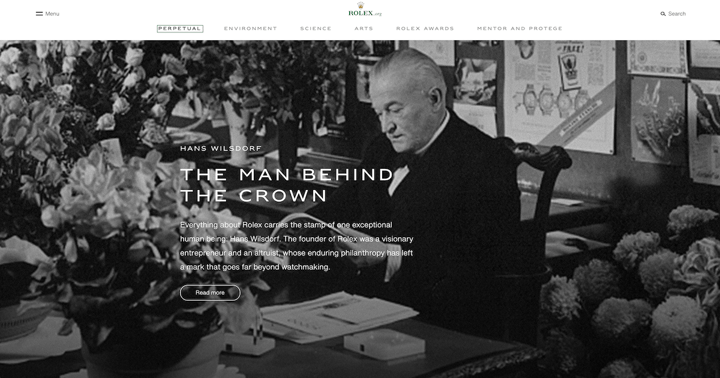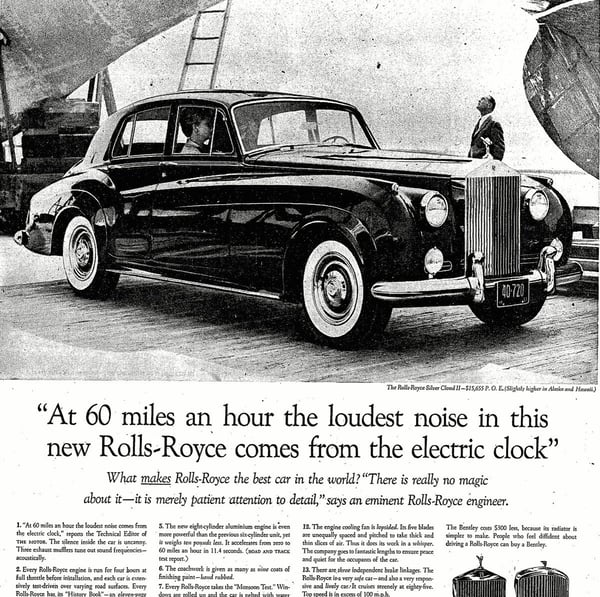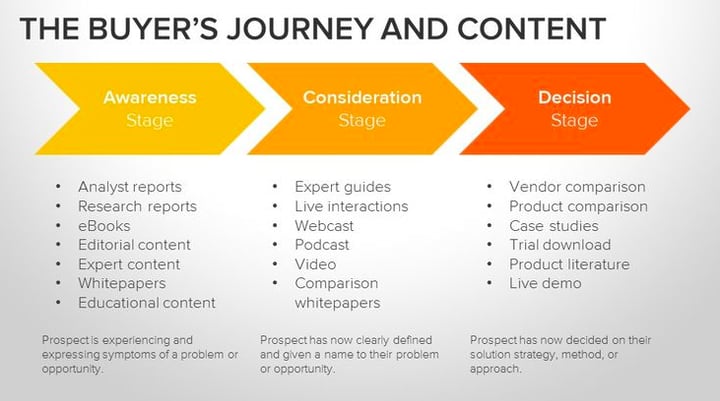Modern brands build connections with their customers not through the products they sell but from the stories they tell.
Introduction - the Rolex story
Rolex – one of the world’s best-known brands — has always distinguished itself through its luxury timepieces. Only watch aficionados can speak of the intricacies of a Patek Philippe or Audemars Piguet, but everyone has heard of Rolex.
In 2018, at a sprightly age of 113 years old, Rolex launched rolex.org, a website focused on showcasing its brand storytelling around its concept of 'Perpetual Spirit'.
Through immersive storytelling, beautifully crafted photos and videography, the website immerses you in all forms of content that paint a picture of not just what Rolex does (sell watches) but what they stand for - an unceasing quest for excellence.
What is even more interesting for a brand that typically has an air of mystery around it, Rolex gives you a peek behind the curtains into the history of Rolex and its founder, Hans Wilsdorf.

Here to me, is the clincher from Rolex:
“Our watches are built to last. So is our contribution to future generations.”
Rolex connects its brand values to an overarching grand vision of what its company stands for and aspires to be. Utilising content marketing in a powerful way to not just reach their target audience but to inspire a movement around their brand philosophy.
Why am I sharing this story?
The first reason is that you are never too old or your business too big to get into content marketing. Rolex’s example here proves that you can extend your brand values beyond just your products, and connect with your customers in a brand new way.
The second reason is that modern brands are able to build connections with their customers not just from the products they sell but through the stories they tell. Simon Sinek famously said in a TED talk, “People don’t buy what you do, they buy why you do it”.
Content marketing is a great way for businesses to use storytelling in content that builds trust with their customers, create brand loyalty and help you reach business goals at the same time.
Let's start from the very beginning.
What is content marketing?
The first rule of content marketing is that content marketing is not about you. It’s about your audience.
Here’s a definition of content marketing:
“Content marketing is the process of creating valuable, relevant content to attract, acquire, and engage your audience.”
Here’s the rub. According to HubSpot's research, people feel ads are annoying, intrusive and disruptive.
- 91% of consumers say that ads are more intrusive today than a few years ago
- 87% agree there are more ads in general
- 79% feel that they’re being tracked as a result of retargeted ads
People are feeling a little averse to ads these days. Marketing that disrupts is no longer effective. What's the alternative?
That's where having high-quality content can make a real difference.
Great content can hook people in and win their short attention spans. People enjoy reading high-quality content without feeling like you are trying to sell to them.
On a related note (pun intended), content marketing and inbound marketing are close siblings. In fact, it's commonly used interchangeably.
As a recap, here’s what we described inbound marketing as:
“Inbound marketing is a business methodology that attracts customers by creating valuable content and experiences tailored to them. While outbound marketing interrupts your audience with content they don’t always want, inbound marketing forms connections they are looking for and solves problems they already have.”
Good content is the foundation of inbound marketing.
The aim of both content and inbound marketing is to create a relationship with your audience by establishing your brand as a trusted authoritative resource to ultimately gain loyalty and credibility.
And of course, it sure helps if all this drives business goals and revenue. Right? 😉
The value of content marketing
Paid ads and landing pages can only do so much to educate your customers on why they should buy from you.
When paid ads and sales don't hit the mark for a business, a good content marketing strategy can help you grow organically and create demand for your brand.
Ultimately, this approach can help you drive sales.
What problems does content marketing solve?
- More organic traffic for your website
- Reach and attract new customers
- Engage your potential customers
- Drive demand generation
- Create brand preference
- Build brand awareness
As with every marketing endeavour, content marketing isn’t a magic bullet. You cannot rank on the first page of Google in one day with a blog.
But does it actually work?
Take Buffer's example. From bootstrapping their business in the early days to reaching an ARR (Annual Recurring Revenue) of $15 million, Buffer has made content marketing a core part of their marketing strategy. Their marketing blog now reaches more than 1 million+ visitors a month.
That's quite amazing for starting with just a blog.
But not entirely unsurprising. According to HubSpot, marketers who prioritized blogging received 13X more ROI than companies that did not in 2019. How's that for value?
Types of content marketing
This blog post that you are reading right now is content marketing.
But content marketing is more than just blogging. In fact, two new kids on the block for content are podcasts and videos.
Here are some mind-boggling facts.
There are 30 million podcast episodes in 2021. YouTube, the number one platform for watching videos now has over 1 billion views every single day.
Now, before you go start your own podcast or YouTube channel, it's important to note that it's not about the form in which you choose to create your content.
What matters more is the type of content your audience consumes. This is the golden rule: content marketing is first tailored to your audience and meeting them where they are.
Your customers may be listening to a podcast on the commute to work, watching a few videos while in the lobby of their office building (pre-COVID) or scrolling through social media when waiting in line for a coffee.
Here are some common types of content marketing:
- Blogs
- Video
- Ebooks
- Podcasts
- Webinars
- Infographics
- Social media
- White papers
- Email newsletter
- Slideshow presentations
Almost all of these forms of content marketing are digital. Some are posted on platforms that distribute them through algorithms like YouTube or LinkedIn.
Let's also never forget that content can still take the form of leaflets, brochures and in-person product demos.
How about some inspiration from a French tyre company?
The Michelin guide, published in 1900, was printed initially as a guide for French motorists. The first edition of 35,000 copies was published and distributed for free.

Their goal was simply to provide useful information such as maps, tyre repair shops and hotels throughout France. This eventually extended to restaurant reviews and the eponymous Michelin Star was born.
The takeaway is this — it's less about the format and more about the audience.
Content distribution channels
So the saying goes: "Build it and they will come."
Well, that's not entirely true in the world of content marketing. Your audience is not obligated to come to you.
This is a good way to summarise content marketing:
Content marketing = content creation + distribution
Without distribution, you are merely creating content and not doing content marketing.
We can categorise distribution channels into two types: Channels you own (internal channels) and external channels.
Types of internal channels
- Knowledge base
- Email newsletters
- Owned websites
- Blogs or resource library
- Micro-sites and event sites
- Social media (eg Facebook, LinkedIn)
- Search engine marketing (SEM)
- Link aggregators (eg Reddit)
- SEO (Google)
- Guest blogging
- News websites
- Paid advertising
- Earned media
Earned media is when your audience chooses to share your content with their own circle of influence. This is hard to earn but is a good reason to aim for writing high-quality content.
The best example of earned media I can think of is employee advocacy. What this simply means is employees sharing brand content or even creating brand-related content.
One of the best platforms to see this at work is LinkedIn. If you'd like, check out this podcast with our very own Nathan Reiche on how to use LinkedIn marketing for your business.
If you don't yet have a blog and want to get started, we've written a helpful step-by-step resource on how to start a blog.
Content marketing vs traditional marketing
Content marketing is a tale as old as time.
While the term may be coined in the new millennium, the practice of creating valuable content has existed for a long time.
Have a look at this ad by David Ogilvy for Rolls Royce. Is it content marketing or traditional marketing?

Well, I'd personally categorise it as content marketing if Mr Ogilvy would let me.
At this point, you may be wondering, "If content marketing is so effective, why do traditional marketing at all?"
We are not advocating abandoning all forms of marketing including paid ads. In fact, great content can find the right audience when paired with paid ads.
It's no doubt that content marketing works. Big brands such as HubSpot and other startup unicorns, have fully adopted it as a growth strategy because it works.
But traditional marketing has evolved as well, with new technologies changing how some formerly "traditional" marketing is done. Instead of billboards, we see digital display ads. Instead of newspapers, we now go to social media for news.
I don't see it as opposing one another. Both of them in fact are needed for marketing to generate results.
Here are some ways in which content marketing differs from traditional marketing.
1. Content marketing is focused on educating, not selling
Traditional advertising is focused on products and services with the goal of getting you to buy a brand’s products. Content marketing is focused on providing valuable content to your potential buyers to move them down the marketing funnel.
2. Content marketing is playing the long game
Content marketing is not a shortcut to increasing sales and must be treated as a long term strategy. Investing in content marketing will pay dividends over the long run. Traditional marketing typically is more short-term focused.
3. Content marketing focuses on getting customers to come to you
Traditional marketing is based on reaching out (push) to customers. Content marketing is about getting your customers to reach out to you (pull).
As traditional marketing becomes less effective and relevant over time, modern marketing has needed to adapt to the changing business landscape.
Adopting content marketing as a strategy means moving away from "interruption" to "permission" based marketing.
Seth Godin says this about permission marketing:
"Permission marketing turns strangers into friends and friends into loyal customers. It’s not just about entertainment – it’s about education."
Content marketing strategy
Don't fall into this trap. Most businesses today create plenty of content that falls under the “free but useless” bucket.
You want to be producing content that is “free but useful.”
Here's a simple outline for crafting an effective content marketing strategy:
1. Develop your SMART goals
As with any marketing strategy, you want to begin with the end in mind. And that means crafting a SMART goal plan.
Here are some examples of goals:
- Improve brand awareness
- Boost revenue
- Increase conversions
- Improve brand loyalty
- Increase customer engagement
- Build rapport and trust among prospects and customers
- Attract strategic partners
2. Think like your customer
Before creating content for your target audience, it's very helpful to start thinking like your customer and create buyer personas.
What's a buyer persona? According to HubSpot, a buyer persona is a semi-fictional representation of your ideal customer based on market research and real data about your existing customers.
The best way to think like your customer is to reach out to actual customers.
Talk to them and find out what they actually think about your product, and use this info to craft content. What this means is that you will actually create content that your target audience actually relates to. Relatable content increases the chance your content is adding value to your audience.
Things you can consider asking:
- What problems are they trying to solve?
- What challenges are they trying to overcome?
- What do they actually need from you?
3. Create your content
Having set up your SMART goals and identified your buyer personas, you are now prepared to develop your content.
A useful framework to think about what content to create is to think about the different stages in the buyer's journey for your product and brand.
Here's a great example of what that looks like from HubSpot:
 4. Distribute your content
4. Distribute your content
Delivering your content to your audience is a crucial factor in your overall strategy. You can't just write content and hope that somehow Google will magically deliver organic traffic. This is a "publish and pray" approach and it doesn't work.
To effectively send audiences to your content, you will need to pair it with the right distribution channels. This could be LinkedIn, Facebook or an email newsletter. Paid social is a great way to amplify your content and get more website traffic.
Pro tip: repurpose old content and schedule them to go out on social media. No content is ever truly wasted and you can repurpose any and all of it to get maximum results.
5. Measure your outcomes
Consider how your content is performing by measuring the data and conversion rates. Is the piece of content producing your desired results?
Use the KPIs you set when planning your SMART goals as a benchmark on whether this content is producing the desired outcome. A small thing to note — even if your content fails to convert or acquire new customers, it will still help improve engagement among existing customers.
You also want to know how your audience is engaging with your content. Consider whether they are sharing, commenting or forwarding it to their circles of concern. Does your content have the sharability factor?
From these results, you gain an extra data point to use to improve and tweak your content marketing strategy accordingly.
Conclusion
Content marketing is suitable for businesses of all sizes. There's no reason not to test it.
As a final takeaway, here are some golden rules for content marketing:
- Content marketing is meant to be educational, not promotional
- Focus on the quality not just the quantity of your content
- Create content that's valuable for your target audience at every stage of their journey
As you start implementing this for your own business, remember that content marketing is playing the long game. Every piece of content you create has a value that pays dividends over the long run.
If you need help, we are a content marketing agency with heaps of experience that can help you craft the right strategy that attracts an audience, converts leads and builds authority.
Go for it!

